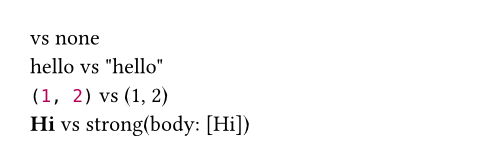未翻訳
このページはまだ翻訳されていません。原文の内容が表示されています。
repr
Returns the string representation of a value.
When inserted into content, most values are displayed as this representation
in monospace with syntax-highlighting. The exceptions are none,
integers, floats, strings, content, and functions.
Note: This function is for debugging purposes. Its output should not be considered stable and may change at any time!
Example
#none vs #repr(none) \
#"hello" vs #repr("hello") \
#(1, 2) vs #repr((1, 2)) \
#[*Hi*] vs #repr([*Hi*])

引数引数引数は関数への入力値です。関数名の後に括弧で囲んで指定します。
引数
引数は関数への入力値です。関数名の後に括弧で囲んで指定します。
repr(any)->valueany必須引数必須引数必須引数は、関数を呼び出す際に必ず指定しなければなりません。位置引数位置引数位置引数は順序通りに指定することで、引数名を省略して設定できます。
valueany
必須引数
必須引数
必須引数は、関数を呼び出す際に必ず指定しなければなりません。
位置引数
位置引数
位置引数は順序通りに指定することで、引数名を省略して設定できます。
The value whose string representation to produce.